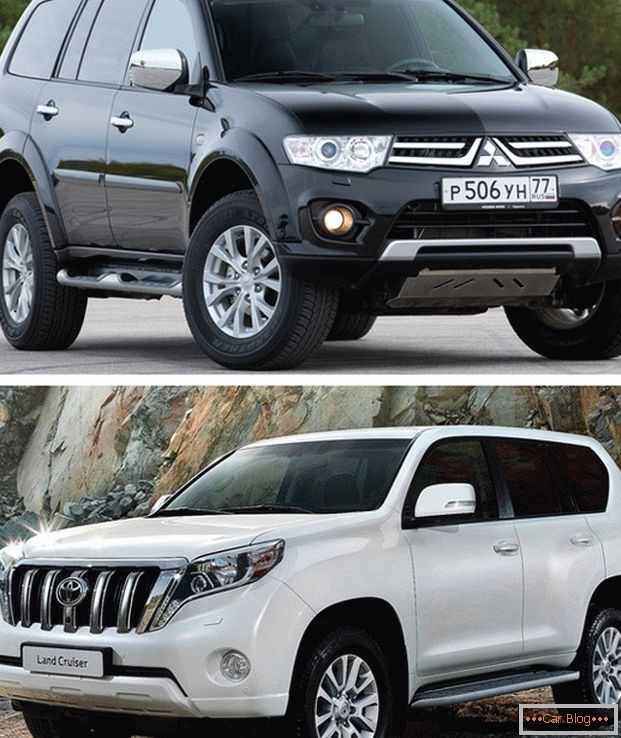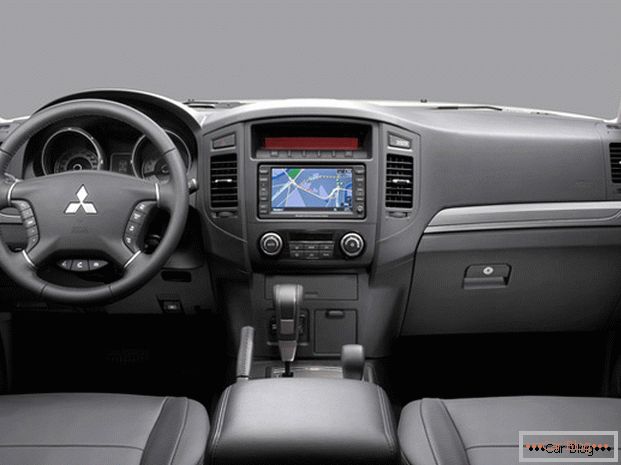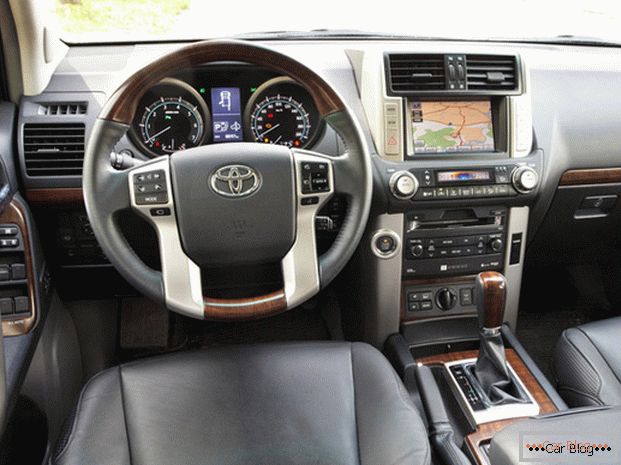>
In the minds of most people, large SUVs are associated with powerful engines - in many ways, this stereotype was established thanks to American technology and the classic Toyota Land Cruiser, equipped with eight-cylinder powertrains. However, the global trend towards fuel economy penetrates even into such a segment that was previously considered unshakable - an example of this is the “younger brother” of the aforementioned Toyota Prado, for which the base engine is a 2.7 liter gasoline engine. And maybe for such large and slow cars a powerful motor is just an extra burden, increasing the risk and contributing to the increase in operating costs? To find the answer to this question, it is necessary to compare the Toyota Prado with a direct competitor, which is the Mitsubishi Pajero. In addition, we will also be able to figure out which vehicle is better suited for everyday use - the Pajero or Prado, as it is of great interest to many people who plan to buy a full-size SUV.

Mitsubishi Pajero and Toyota Land Cruiser Prado – какой внедорожник лучше выбрать?
Читать далее о сравнении Митсубиси Паджеро или Тойота Ленд Крузер Прадо-->
Comparison over time
Immediately about the engines
Since one of our tasks is to consider motors, we should start with dynamic characteristics. A more solid power unit offers its fans Mitsubishi Pajero - its volume is 3.0 liters, and the performance reaches 178 horsepower. Yes, and automatic transmission is very good for a large SUV - a classic hydromechanical unit with five steps. Of course, the Mitsubishi Pajero with the base engine should not participate in the rally, as the reaction to pressing the gas pedal is very smooth, and even pushing it “to the floor” does not lead to rapid acceleration.
Driving in traffic jams on the Mitsubishi Pajero is enjoyable - not only does the driver enjoy a high ride, he also does not feel any discomfort during small movements. The start of the movement on the Mitsubishi is very smooth - so much so that you do not always have time to note the moment in which the transmission after a little delay begins to transfer energy to the wheels. But if you need active maneuvering, you want to complain about some “thoughtfulness” of the gearbox - the car can make you wait a couple of seconds before you get what you want from it.
| Car model: | Mitsubishi Pajero | Touta Lant Kruser Prado 150 |
| Producing country: | Japan | Japan (Build - Russia, Vladivostok) |
| Body Type: | SUV | SUV |
| Number of places: | 7 | 7 |
| Number of doors: | 5 | 5 |
| Engine capacity, cubic cm: | 2972 | 2694 |
| Power, l. c./about min .: | 178/5250 | 163/5200 |
| Maximum speed, km / h: | 175 | 165 |
| Acceleration to 100 km / h, from: | 12,6 | 12,5 |
| Type of drive: | Full | Full |
| CAT: | 5 automatic transmission | 4 automatic transmission |
| Fuel type: | Gasoline AI-92 | Petrol AI-95 |
| Consumption per 100 km: | In the city of 15.9 / Out of town 10.0 | In the city of 16.2 / Outside the city of 10.5 |
| Length, mm: | 4900 | 4780 |
| Width, mm: | 1875 | 1885 |
| Height, mm: | 1870 | 1845 |
| Clearance, mm: | 235 | 220 |
| Tire size: | 265/65 R17 | 265/65 R17 |
| Curb weight, kg: | 2100 | 2095 |
| Full weight, kg: | 2810 | 2850 |
| Fuel tank capacity: | 88 | 87 |
If we talk about what is better - Pajero or Prado, then in this case, you can make an unequivocal choice. Looking at the aggressive appearance of Toyota, you involuntarily begin to think that the car is more dynamic - and you are mistaken. The power unit Prado has a smaller working volume of 2.7 liters, and the power is also 15 horsepower lower than that of the Mitsubishi Pajero. In addition, an archaic four-step “automatic” works in combination with this motor. As a result, a Toyota car behaves quite uncertainly on the highway - the car with great difficulty reaches the line of 150 km / h and completely ends its acceleration at 165 km / h.
The situation is somewhat saved by shortened transmission ratios, which allow you to actively maneuver in the city without fear of creating an emergency. But the Toyota Prado has the same problem as the rival Mitsubishi Pajero SUV - the car’s power line allows a delay of a couple of seconds before driving. In addition, other automatic transmission settings somewhat reduce overall comfort - this is manifested in small jerks, as well as in increased noise of the engine, constantly working at high revs. This feature does not allow the Toyota LC Prado to take first place in terms of efficiency - with a smaller engine capacity, the car spends on average 0.5 liters of fuel / 100 km more.
We go beyond the asphalt
Everyone knows that off-road excellent dynamics is not so important - therefore, it would be reasonable to compare Prado vs Pajero in conditions far from the ideal coverage of city roads. If you do not order the most expensive equipment, then the Mitsubishi Pajero is equipped with a fairly simple transmission, the role of means of connecting all-wheel drive in which the viscous coupling plays. Therefore, when driving off-road, you should be careful - the mechanism allows for noticeable slippage. Of course, it is possible to forcibly block the center differential to increase patency, but the node switches itself off as soon as the sensors indicate overheating. But there is no blocking of cross-wheel differentials on the Mitsubishi Pajero at all - only the electronics that slow the movement on one side of the axle can help with hanging the wheel, but it acts a few seconds late, which can also be disastrous.
Test drive a car Mitsubishi Pajero:
Toyota Prado behaves no better - on a serious off-road car can drown in the dirt, not only a novice, but also an experienced professional driver. That's just not to be afraid of overheating of the forcibly locked center differential - there is a multi-disk device under the name Torsen, which is famous for its reliability and endurance. However, it is felt that Toyota’s engineers didn’t set up an automatic transmission for off-road driving - the Prado continually changes gears during a slip. In this case, Mitsubishi Pajero can be ordered with a mechanical transmission and advanced units that improve off-road ability, and the Toyota Prado - no. Therefore, if we compare the Prado and Pajero on rough terrain, the second one will still be more preferable, if not in the configuration that is involved in the comparison.
Comfortable in motion
Several years ago, Mitsubishi's specialists, who were developing the fourth-generation Pajero, made a rather controversial decision, abandoning a full-fledged spar frame in favor of integrated power elements, partially combined with the body. The advantages of such a bold step are felt when landing - the floor of the car is much lower than that of the Toyota Prado. In addition, usually bearing bodies, even if equipped with integrated frames, have better chassis characteristics - but in this case we are dealing with an exception to the rule.
Choosing Prado or Pajero, most car enthusiasts will give preference to Toyota for everyday use - in an attempt to achieve good controllability with a huge mass, as well as to eliminate rolls and valkost, Mitsubishi engineers made the suspension too rigid. The car appreciably bounces on the joints of the roadbed, and also throws up the riders when passing such urban irregularities as protruding manhole covers. On the off-road, I want to slow down and not hurry anywhere - the Mitsubishi Pajero brings back memories of the good old UAZ vehicles, the creation of which did not even think about comfort.
Test drive car Toyota Land Cruiser Prado:
If we continue to compare the Prado and Pajero, then I want to express my deep gratitude to Toyota for installing the air suspension on the car. It is equipped with several modes of operation, but even when choosing the hardest of them, the machine does not create any jolts, no buildup, or even noticeable vibrations when driving at full speed through a deep pit. In addition, off-road ground clearance of the Toyota LC Prado can be increased to 235 mm so as not to catch the bottom of a particularly large bump. The only thing that I would like to eliminate - tangible body tilt during acceleration and deceleration. However, such is the fee for comfort - the Toyota Prado could be forgiven and more.
Presentable
Body and appearance
It is no secret that in our country SUVs are sometimes bought solely due to their solid appearance, which makes a person feel more confident and representative. Compared with the third generation, the fourth Mitsubishi Pajero once looked very serious and aggressive, but on the background of the new Prado, this feature is lost. Of course, the front part of the body looks very solid thanks to the large headlights, as well as the horizontal grille with two chrome strips. However, on the side of the Mitsubishi Pajero does not cause any enthusiasm - rounded shapes look "zamylennymi". When you look back, you mentally return about 10–15 years ago, when the installation of a spare wheel on the fifth door was very fashionable.

Car Mitsubishi Pajero with each update became more serious and more aggressive
If you choose which car to buy to impress others - Mitsubishi Pajero or Toyota Prado, you should give preference to the latter. The first thing that catches the eye, and no longer comes out of attention - the "grin" of a huge grille with five massive vertical bars. In addition, the front lighting with a narrow central segments that go down to the plastic surface of the bumper looks very stylish. The lines of the roof and windows of the Toyota LC Prado are straight - so the silhouette looks much more dynamic than the Mitsubishi Pajero. At the rear, Toyota also makes a good impression due to the vertical fifth door and the sharp edges of the lanterns.

The appearance of the car Toyota Land Cruiser Prado leaves more positive impressions
Interior - Design and Capacity
When you get to the driver's seat of Mitsubishi Pajero, you immediately pay attention to a simple four-spoke steering wheel, which looks not only alien, but also too cheap for an SUV of a similar cost category. However, the claims on this end - the front panel looks simple, but such simplicity evokes thoughts about convenience, and not about poverty. The vertical layout of the center console of the Mitsubishi Pajero is clearly “peeped” by American designers, as well as the huge tunnel between the front seats, onto which you can install a custom plastic cover that simulates wooden veneer. Mitsubishi Pajero devices are traditional - two large scales, between which there is a modest screen of the trip computer.

Mitsubishi Pajero boasts leather upholstered seats with convenient control elements.
The front seats of the Misubishi with leather upholstery are chic - with extreme fatigue, you can fall asleep in just a couple of minutes and wake up in a few hours without feeling discomfort. The backrest and cushion profile is perfect, but after a few hours of continuous driving, I want to change my body position due to insufficient frame stiffness. There is a lot of space in the back row - even people of large build will be able to stay in the Mitsubishi Pajero three of them, without feeling discomfort. When the Prado and Pajero tests were carried out, cars with a third row of seats were selected, on which two more people could be accommodated - only it is better to plant children here  Discounts for new cars! Profitable loan from 9.9% installments 0%
Discounts for new cars! Profitable loan from 9.9% installments 0%  adom.ru with an increase of not more than 1.6 meters. And anyway, they will be cramped, and when folding additional seats a high step is formed, therefore, if it is useless in Misubishi Pajero, it is better to simply dismantle them.
adom.ru with an increase of not more than 1.6 meters. And anyway, they will be cramped, and when folding additional seats a high step is formed, therefore, if it is useless in Misubishi Pajero, it is better to simply dismantle them.
Interior designer Toyota Prado obviously used only the ruler, forgetting about compasses and other drawing devices. The entire front panel of the car is composed entirely of straight lines, and the center console is a collection of rectangles of various dimensions. Even the steering wheel of the Toyota Prado has wide spokes that give it a “straightened” look. An exception was made only for devices that are very similar to the similar two scales in Mitsubishi Pajero.

Saloon car Toyota Land Cruiser Prado отличается наличием прямых линий
The front seats of the Toyota Prado have what the competitor lacks - a rigid frame, due to which they do not annoy the inconvenience under any circumstances. Frame layout Toyota Prado has its drawbacks - on the second row there is not less space, but the seat itself is much higher and has a shortened pillow. But compared to the Pajero vs. Prado, the Toyota Prado definitely wins over the seats in the luggage compartment due to the opportunity to seat people here with an increase of up to 1.8 meters, as well as the best transformation mechanism that allows you to get a perfectly flat floor.
Do I need expensive equipment?
Considering that large SUVs in our country are bought mainly for the sake of a representative appearance, power could be relegated to the background. But too slow cars - especially the Toyota LC Prado. And yet this particular car is perceived much better than the Mitsubishi Pajero - thanks in large part to better comfort, all other things being equal. Low power would not be a hindrance on the roads - only in the basic configuration, cars with fairly simple transmissions should not be far from a good road.



